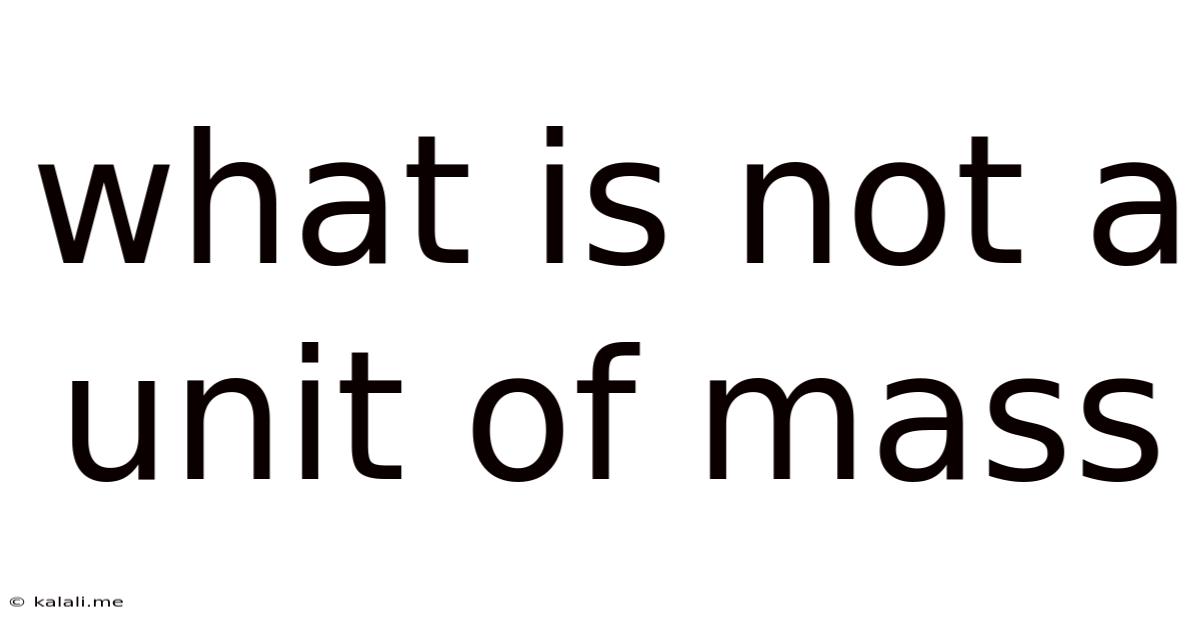What Is Not A Unit Of Mass
Kalali
Jun 13, 2025 · 3 min read

Table of Contents
What is NOT a Unit of Mass? Understanding Measurement and Units
This article explores the fundamental concept of mass and clarifies which units are not used to measure it. Understanding the difference between units of mass and other physical quantities is crucial in various scientific and everyday contexts. We'll delve into common misconceptions and provide clear examples.
Mass, simply put, is the amount of matter in an object. It's a fundamental property that determines an object's inertia – its resistance to changes in motion. While weight is often confused with mass (and is related through gravity), they are distinct concepts. Weight is a force, while mass is a property of matter.
So, what units don't measure mass? Let's explore:
Units That Do NOT Measure Mass:
-
Units of Length: Measurements like meters (m), centimeters (cm), kilometers (km), inches (in), feet (ft), miles (mi), etc., quantify distance or length, not the amount of matter. They describe spatial extent, not mass.
-
Units of Time: Units such as seconds (s), minutes (min), hours (hr), days, years describe duration or the passage of time, unrelated to the quantity of matter.
-
Units of Volume: While volume and mass are related (a denser object will have more mass in the same volume), they are not interchangeable. Units like liters (L), cubic meters (m³), gallons (gal), cubic centimeters (cm³) describe the amount of space an object occupies, not its mass. Think of a kilogram of feathers versus a kilogram of lead: they have the same mass but drastically different volumes.
-
Units of Force: Force is measured in Newtons (N), dynes, pounds-force (lbf). Weight, being a force, is measured in these units. Although related to mass through the equation F = ma (Force = mass x acceleration), force itself is not a measure of mass.
-
Units of Energy: Energy, measured in Joules (J), calories (cal), kilowatt-hours (kWh), represents the capacity to do work. It's not directly related to the quantity of matter.
-
Units of Temperature: Temperature, measured in Celsius (°C), Fahrenheit (°F), Kelvin (K), indicates the degree of hotness or coldness of an object, not its mass.
-
Units of Speed and Velocity: Measurements like meters per second (m/s), kilometers per hour (km/h), miles per hour (mph) describe the rate of change of position, not the amount of matter.
Common Mistakes and Clarifications:
One common mistake is confusing weight and mass. While related (weight is the force of gravity on an object's mass), they are fundamentally different quantities. On the moon, your weight would be less due to lower gravity, but your mass remains the same.
Another common area of confusion involves density. Density (mass per unit volume) uses units like kilograms per cubic meter (kg/m³) or grams per cubic centimeter (g/cm³). While density incorporates mass, it's not a unit of mass itself. It's a derived unit, combining mass and volume.
In conclusion, understanding the difference between units of mass and other physical quantities is crucial. Focusing on the core definition of mass – the amount of matter – helps clarify why certain units are unsuitable for measuring it. Remember, the fundamental units of mass are kilograms (kg) and grams (g) in the metric system, with others being derived or multiples thereof.
Latest Posts
Latest Posts
-
How Many Chicken Thighs In A Pound
Jul 01, 2025
-
How Old Is Someone Born In 1992
Jul 01, 2025
-
How Many Grams Is In A Pint
Jul 01, 2025
-
Lyrics To The Song Stand By Donnie Mcclurkin
Jul 01, 2025
-
How Much Is 3 Quarts Of Water
Jul 01, 2025
Related Post
Thank you for visiting our website which covers about What Is Not A Unit Of Mass . We hope the information provided has been useful to you. Feel free to contact us if you have any questions or need further assistance. See you next time and don't miss to bookmark.